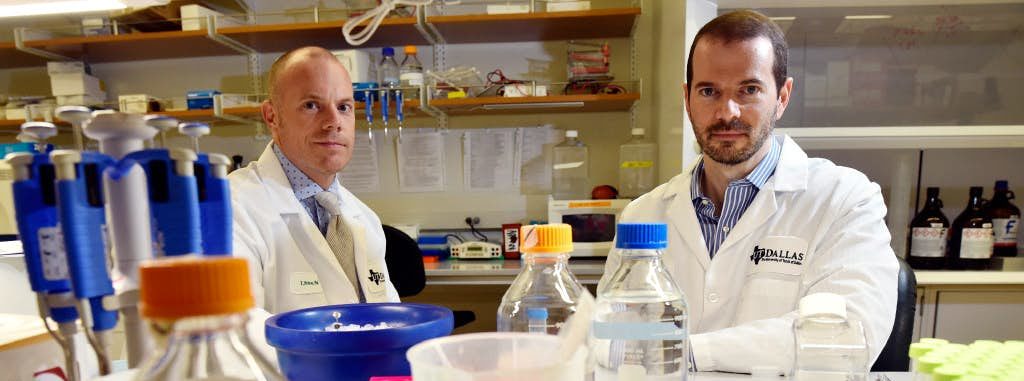Pain sensitivity after an injury, such as damage to a nerve or an inflammatory insult, involves the synthesis of new proteins in pain neurons. This process is thought to play a role in the transition from acute to chronic pain, suggesting that blocking it may prevent chronic pain from developing in the first place. Now, a new paper reports a novel strategy to inhibit protein synthesis and stop pain in mice.
Category: News
Imagining A Future Without Opioids
Since 2000, more than 300,000 Americans have died after overdosing on opioids, according to the CDC. Dr. Ted Price researches chronic pain at UT Dallas and he joins us to talk about arguably America’s most important public health crisis—and about the prospects for non-opioid pain medication.
Dr. Ted Price: Clarifying the Causes of Chronic Pain and Creating New Treatments
Dr. Theodore (Ted) Price is an associate professor in the School of Behavioral and Brain Sciences at the University of Texas, Dallas. He is also a neuroscientist with and the founder of a startup company called Ted’s Brain Science Products which develops non-opioid pain management products. Ted received his B.S. degree in neuroscience from the University of Texas, Dallas and his PhD in Pharmacology from the University of Texas Health Science Center, San Antonio. Ted completed postdoctoral fellowships at the University of Texas Health Science Center, San Antonio and at McGill University. He served on the faculty at the University of Arizona College of Medicine before joining the faculty at UT, Dallas. Ted has received numerous honors and award for his work, including the American Pain Society John C. Liebeskind Early Career Scholar Award, the Louis J. Kettel Faculty Mentor Award from the Department of Surgery, the University of Texas at Dallas Buhrmester Rising Star Award, the Vernon and Virginia Furrow Award for Graduate Education from the University of Arizona, and the Patrick D. Wall Young Investigator Award from the International Association for the Study of Pain. Ted joined us in an interview to share stories from his life and science.
UTD Team Looking to New Weapon in Fight Against Addiction
In the middle of the nation’s opioid epidemic, doctors in Dallas are looking for long-term pain relief without the harmful effects of narcotics.
Texas Pain Research Consortium Defies Hurricane Harvey to Host Second Biennial Pain Research Conference
On August 24, 2017, the Texas Pain Research Consortium hosted its second biennial scientific meeting beachfront at the historic Hotel Galvez in Galveston, Texas. The meeting was organized by the consortium’s co-chairs, Ted Price and Jin Mo Chung, and hosted by the University of Texas Medical Branch with support from the UT system, the Gulf Coast Consortia, and Purdue Pharma. Despite the looming Hurricane Harvey, there was an impressive turnout of 133 attendees including basic scientists, clinicians, postdoctoral trainees, and graduate students from 19 universities across Texas.
How a University of Texas at Dallas startup aims to develop non-opioid pain relief drugs
Ted Price used to believe that people who abused opioids suffered from a failure of will. But after a freak spinal cord injury in 2006, Price’s views changed.
“I could see [the pain]. It was bright. That’s how I describe it. It felt like there was a vise around my leg that was on fire. … It was unbelievable how awful it was,” Price said.
The opioids that doctors gave him didn’t do anything to help. Surgery alleviated the pain, but the scars of how much everything hurt still haunt him.
Price believes people become hooked out of their desperation for relief — and they’ll use opioids even though the drugs are addictive and can result in overdoses. Opioid abuse “comes out of a desire that people have to make pain go away,” Price said. “And anybody that’s ever had pain for any period of time knows what that feels like. You want it to go away.”
Texas can solve the problem of chronic pain
The tragic, high-profile death of Prince has shed much-needed light on a growing epidemic of chronic pain and prescription drug misuse in the United States.
Chronic pain affects as many as 100 million Americans — people who are hurting and desperately looking for a solution. In an effort to fight the pain, many have turned to opioids — drugs that help relieve the discomfort.
Opioids, including codeine, hydrocodone and Dilaudid, are among the most widely prescribed drugs for pain.
Unfortunately, these medicines also have led to a rise in overdoses, now a leading cause of death among Americans.
Study shows dopamine may play role in chronic pain
Researchers from the University of Texas (UT) at Dallas and others traced the path of pain signals between the brain and spinal cord in mice and found removing a group of dopamine-containing cells selectively reduced chronic pain.
Senior author Ted Price, associate professor in behavioral and brain sciences at UT Dallas, says the study reveals a new role for dopamine in helping maintain chronic pain states, and suggests:
“This may open up new opportunities to target medicines that could reverse chronic pain.”
Capitalizing on Neuronal Plasticity to Develop New Analgesic Drugs: A Conversation With Ted Price
Theodore “Ted” Price, PhD, studies the role of pain plasticity mechanisms in the development of chronic pain, always with an eye toward generating novel therapeutics that can prevent or reverse the condition. He recently set up a new lab at the University of Texas at Dallas, US, where he is an associate professor in the School of Behavioral and Brain Sciences. Previously, he was an associate professor of pharmacology at the University of Arizona, Tucson, US. In 2014, Price won the Patrick D. Wall Young Investigator Award for Basic Science from the International Association for the Study of Pain. Neil Andrews, PRF executive editor, spoke by telephone with Price about his route to becoming a pain researcher, his experience setting up a lab for the second time, and the research projects he is working on now. Price also shared his perspective on how to identify promising targets for drug development, the pain field’s efforts thus far to develop new analgesics, and pain research trends he finds promising. Below is an edited transcript of the conversation.
A Pain Protection Plan in the CNS?
Why does injury or surgery in some people lead to lasting pain, while in others the wound heals and the pain resolves along with it? A new study takes on that question by comparing rats that develop chronic pain after nerve injury with identically injured animals that do not. Researchers directed by Frank Porreca and Theodore Price at the University of Arizona, Tucson, found that differences in pain modulation by the central nervous system underlie the rats’ opposite fates. The data suggest that descending inhibitory mechanisms protect some rats by continuously blocking pain. The study, led by first authors Milena De Felice, Raul Sanoja, and Ruizhong Wang, was published online July 9 in Pain.



